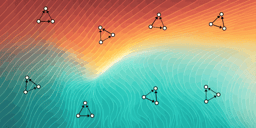Quantum double lock-in amplifier
Published in Physics

The precise measurement of weak alternating signals in a noisy background is of great significance in both fundamental scientific research and practical applications. Typically, the desired signal is obscured by the noise, making detection challenging.
Typically, when dealing with time-dependent alternating signals of known initial phase, conventional quantum lock-in amplifier using a single reference signal can effectively extract the characteristics of the target signal with high signal-to-noise ratio, which have been realized by Shlomi Kotler et al. [Nature volume 473, pages 61–65 (2011)]. However, when the initial phase is unknown, extracting the complete characteristics, including amplitude, frequency, and initial phase, becomes challenging with a single reference signal alone. Inspired by the classical double lock-in amplifier, we propose a quantum lock-in amplifier for measure a weak alternating signal with unknown initial phase.
Here, we present a general protocol for achieving a quantum double lock-in amplifier by employing two quantum mixers operating under orthogonal pulse sequences. To demonstrate the practical implementation, we discuss the experimental feasibility using a five-level double-$\Lambda$ coherent population trapping system with Rb atoms. Notably, the five-level double-$\Lambda$ system significantly reduces the total measurement time by nearly half and mitigates time-dependent systematic errors compared to conventional two-level systems.
General protocol
In analogy to a classical double lock-in amplifier, a quantum double lock-in amplifier can be realized by using two orthogonal multi-pulse sequences, which act the role of two orthogonal reference signals (see Fig1). Generally, to realize a quantum double lock-in amplifier, one can choose any two multi-pulse sequences whose filtering functions are orthogonal. Here, we choose the periodic dynamical decoupling (PDD) and Carr-Purcell (CP) sequences as an example. In the example, the PDD and CP sequences correspond to the two orthogonal reference signals sin and cos signal in classical double lock-in amplifier, respectively. Here the half period of the two reference signals is the spacing of the adjacent pulses, thus one can extract the target signal by modulating the spacing of the adjacent pulses.

To show the validity of our protocol, we divide the target signals into two types: weak and strong signals. For a weak target signal, the lock-in point can be determined by exploiting the symmetry of the combined measurement signal, allowing for subsequent extraction of the amplitude and, the phase through a fitting procedure. For a strong target signal, the target signal can be extracted from the FFT spectrum of the combined measurement signal.
Experimental feasibility
The quantum double lock-in amplifier can be realized in the five-level double $\Lambda$ coherent-population-trapping (CPT) system. Under some conditions, such a system can be divided into two single-$\Lambda$ systems. To achieve our quantum double lock-in amplifier, we can simultaneously prepare two dark states as the initial states by a CPT pulse. After the initialization via CPT pulse, the prepared two dark states can independently accumulate phases under the control of PDD and CP sequences, respectively. During the signal interrogation process, the applied PDD and CP sequences only couple the ground states in the same quantum mixer, see Fig2(a). At last, a CPT query pulse of 2 μs is imposed to obtain the population of the common excited state, see Fig2(b). Here, the transmission of CPT light can be converted as the transmission signal via a photodetector, and the absorption is proportional to the excited-state population. Therefore, one can extract the target signal from the population of the common excited-state in this system.

Compared to the implementation using two-level systems, our experimental proposal based on a five-level system can significantly reduce the total measurement time and avoid additional time-dependent systematic errors.
Robustness
In experiments, there are many imperfections that may influence the lock-in signal. Here, we main illustrate two key imperfections: the finite pulse length and the stochastic noises. For the finite pulse length, we find that the pulse length does note affect the frequency measurement. Meanwhile, the effect of pulse length can be ignored for the amplitude and phase measurement when the pulse length is less than 0.2 times the period of the signal.
Typically, if the two orthogonal periodic multipulse sequences are synchronized with the target signal, the phase accumulated owing to the target signal adds up coherently, whereas the phase accumulated owing to stochastic noise can be averaged away. Especially, if the frequencies of the noise spectral components are far from the signal frequency, the noise spectral components can be removed in the long-time integration. The frequency spectrum of white noise is uniformly distributed, while the PDD and CP sequences only corresponds to the specific frequency. Therefore, quantum double lock-in amplifier is also robustness against the white noise. Meanwhile, the frequency of target signal is much higher than 50Hz in our consideration, thus the 50Hz noise also can be filtered well and the quantum double lock-in amplifier is robustness against 50Hz noise.
Furthermore, our study of quantum double lock-in amplifier may provide a pathway to alternating signal measurement, thereby facilitating the development of practical quantum sensors, such as magnetometers, atomic clocks, weak-force detectors, and so on.
Follow the Topic
-
Communications Physics

An open access journal from Nature Portfolio publishing high-quality research, reviews and commentary in all areas of the physical sciences.
Ask the Editor – Space Physics, Quantum Physics, Atomic, Molecular and Chemical Physics
Got a question for the editor about Space Physics, Quantum Physics, Atomic, Molecular and Chemical Physics? Ask it here!
Continue reading announcementRelated Collections
With Collections, you can get published faster and increase your visibility.
Higher-order interaction networks 2024
Publishing Model: Open Access
Deadline: Feb 28, 2026
Non-Markovian quantum dynamics in physical systems: description and control
Publishing Model: Open Access
Deadline: Dec 31, 2025


Please sign in or register for FREE
If you are a registered user on Research Communities by Springer Nature, please sign in